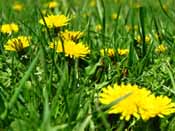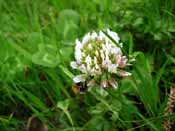
Lawn weeds such as crabgrass and dandelions pose one of the most persistent — and annoying — challenges in the great American quest to grow decent grass. Some weeds are just a fact of lawn life. With a yank here and a zap of weed-killer there, weed control should be no big deal. But if your lawn is losing the weed war, the first place to look is the quality of the grass itself and the soil under it. Weeds are opportunists. They’ll quickly move into any bare spots. When grass plants beat them to the punch, though, they have no place to sprout. That’s why the best defense against lawn weeds is a good offense.
Heading off weed trouble
A good, thick stand of turfgrass solves weed problems faster than anything. If your lawn is thin, overseed it with quality grass seed. Quality grass seed means selecting a grass seed variety that is disease, drought and insect resistant, NTEP rated variety and a species that suits the lawn environment for growing zone and use.
Spring and late summer to early fall is an ideal time to seed the lawn, and it isn’t overkill to add new seed each year until the lawn is thick. Grass seed germinates best when it’s raked lightly into the soil surface and kept consistently moist until sprouting. Grass will only grow as well as the soil underneath allows, so test your soil to be sure you’ve got the optimal acidity level (close to neutral or 7.0 on the pH scale) and adequate nutrients. Remove soil cores with an aerator each fall if you’ve got compacted soil, which is common in sites that were heavily graded or where there’s a lot of foot traffic. Most lawn weeds tolerate compacted soil much better than grass.
One of the most important weed-fighting moves is cutting your grass high — at least 2 inches, or better yet, at 3 inches. Taller grass blades not only shade out baby “weedlings,” but taller blades mean more chlorophyll, which translates into more growth-generating food for the roots.
Monitor for bug and disease problems, and treat those before they get bad enough to undermine grass growth. When overseeding, choose newer grass varieties that have been bred for natural bug and disease resistance.
Finally, if you water your lawn, do it deeply and less often instead of shallow and frequently. Put on enough water that the soil is damp to a depth of 4 to 6 inches so the roots are encouraged to go down after it. Light waterings encourage grass roots to grow close to the surface, where they’re much more prone to dying off in summer heat.
Weed control
How to kill weeds that come up anyway? Before taking action, you have to know the enemy. The type of weeds you’re dealing with will determine what you use and when you use it. Weeds fall into two main camps: annuals and perennials. (There are also a few biennials, but they’re generally treated like perennials.) Annual weeds are ones that sprout anew each year, live their entire life cycle in one year and then produce seed for the next generation. Perennial weeds are those that come back year after year. They also may set seed (or send out runners), but unlike annuals, they don’t die out with the season.
Some common examples of annual lawn weeds: crabgrass, goosegrass, barnyardgrass, foxtail, annual bluegrass, black medic, prostrate knotweed, prostrate spurge, purslane, common chickweed, corn speedwell, dog fennel and henbit.
Some common examples of perennial lawn weeds: dandelion, orchardgrass, quackgrass, nimblewill, yellow nutsedge, wild garlic, plantain, creeping speedwell, cinquefoil, ground ivy, clover, wild violets, yellow woodsorrel and hawkweed.

For help identifying weeds, visit Rutgers University’s New Jersey Weed Gallery at www.rce.rutgers.edu/weeds or Purdue University’s weed-identification pages.
Even if you don’t know the exact names of your weeds, if you can at least notice whether they’re the same ones returning year after year or new ones sprouting from seed, you’ll have a better shot at selecting a weed control product that will prevent and kill weeds in your lawn.
Preventing weeds
For crabgrass control and stopping other annual weeds, the usual game plan is to apply granular weed preventers over the lawn in early spring — ideally right before the weeds germinate. These include products such as benefin (Balan), benefin and trifluralin (Team), pendimethalin (Pre-M and Halts) and prodiamine (Barricade) as well as corn gluten meal, an organic alternative that’s a byproduct of corn. All work best when applied 10 days to two weeks before the top inch of soil reaches 55 to 58 degrees at daybreak for four or five days. That’s roughly (although not always) around the time forsythia bushes start blooming. These products should be applied right before a rain. Otherwise, water them in within two or three days after applying.
What many lawn-owners don’t realize is that none of these products last all season long. Their effectiveness goes downhill after 8 to 10 weeks. That’s especially a problem when summers are rainy, which speeds the products’ breakdown and encourages crabgrass and other summer-annual weeds to keep sprouting — sometimes into August. A second shot of weed preventer put down about 8 weeks after the first one will give later-season weed control. In hot, droughty summers, the weather alone will solve this later-sprouting weed problem (although your lawn also most likely will go brown and dormant, too).
Timing is critical for weed preventers. Apply them too early, and you’ll shorten your later-control period. Apply them too late, and that first round of crabgrass will be up and growing. Further complicating things is that goosegrass starts germinating about three to four weeks after crabgrass, so the timing of a single application gets really interesting.
Our approach is combining two different weed controls in one product — one that prevents and one that kills.
GreenView Fairway Formula Spring Fertilizer Weed & Feed and Crabgrass Preventer provides the combination of weed killer and preventer.
Killing weeds
Once weeds are up and growing, preventers won’t help. They also aren’t effective against existing perennial weeds. To kill weeds at this point, you’ll need a weed-killer (herbicide). Which one of those you use will depend on whether the weed is a grassy one like crabgrass or goosegrass or a broad-leafed one like plantain or dandelion.
Grassy weeds are generally thin, upright and recognized by long, narrow leaf veins that run up and down parallel to one another. Broad-leaf weeds generally have wider leaves that have a main vein down the middle with smaller veins branching out in a netlike pattern. Because these are two different kinds of plants, it’s possible to target weed-killers that will zap one without affecting the other. These products come both in granular form and liquid form.
The most common way lawn-owners use this type of product is in granular form, blended in bags with fertilizer and applied in spring as a “weed-and-feed” application. These work best on weeds that are up and growing and when applied after a rain or in the morning when moisture helps the granules stick to the grass blades. Treating the whole lawn with a weed-and-feed product makes sense when you’ve got weeds all over the whole lawn. But if you’ve just got a few patches of weeds here and there, it’s better to just fertilize separately and spot-spray the weed patches with a liquid herbicide.
Be sure to choose a product that’s labeled for broad-leaf weed control in lawns! These products are formulated so you can spray them on lawns without hurting the grass (assuming you follow the application directions and dilution instructions on the label).
Killing grassy weeds
The going gets a little tougher when trying to kill grassy weeds in lawns. Because these plants are botanically so similar to turfgrass, it’s much touchier to develop a product that targets one without hurting the other.
There are a few products that kill grassy weeds such as crabgrass, goosegrass, yellow nutsedge and the like after they’re growing (i.e. MSMA, DSMA and Acclaim), but all work best when applied early in these plants’ growth stage. Unfortunately, most people don’t distinguish grassy-weed outbreaks until those weeds are so far along that grassy herbicides aren’t terribly effective. Even under ideal conditions, it may take two or three applications to dispatch a grassy-weed problem. This is why it’s much more effective to go after annual grassy weeds like crabgrass and goosegrass before they’ve sprouted. Plus, the chemicals used on grassy weeds aren’t labeled for use at all on most warm-season lawn grasses, such as St. Augustine grass or Bermuda grass.
The saving grace is that annual grassy weeds (like the aforementioned crabgrass and goosegrass) die off when frost arrives. But for perennial grassy weeds like orchardgrass and low-quality tall fescue, you’re probably stuck with either digging out these patches by hand or spot treating the infested area with a systemic herbicide labeled to control these weeds. Be sure to check and follow the product directions, to determine how to apply and when it is safe to reseed the bare patches.
Best time to kill weeds
Obviously, weed preventers must go down before the weeds sprout. Weed-killers, on the other hand, can be applied anytime throughout the season when the weeds are actively growing. Fall is even a very good time to go after perennial weeds as these plants attempt to store energy in their roots before going dormant for winter.
Just be careful about using weed-preventers and weed-killers around the time you’re trying to plant new grass seed. Most of these products will prevent or stunt the growth of new grass, except for products containing siduron (Tupersan). Check the labels for when it’s OK to plant grass before or after applying weed-control products.
Also avoid using weed-control products during droughts when your lawn is brown and dormant. Just stay off it then and do nothing other than water once or twice if the drought drags on more than a month after the lawn has browned. Worry about weeds and everything else after the lawn greens back up.
GreenView Fairway Formula Fertilizers contain weed control herbicides to kill weeds and prevent grassy weeds. See the full range of GreenView Fairway Formula Fertilizers.